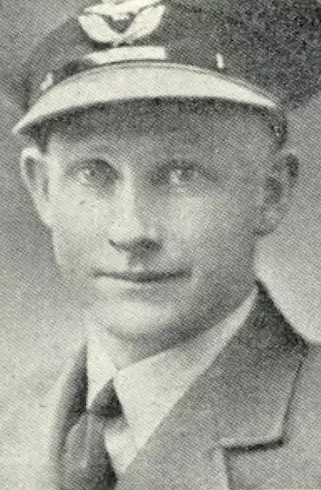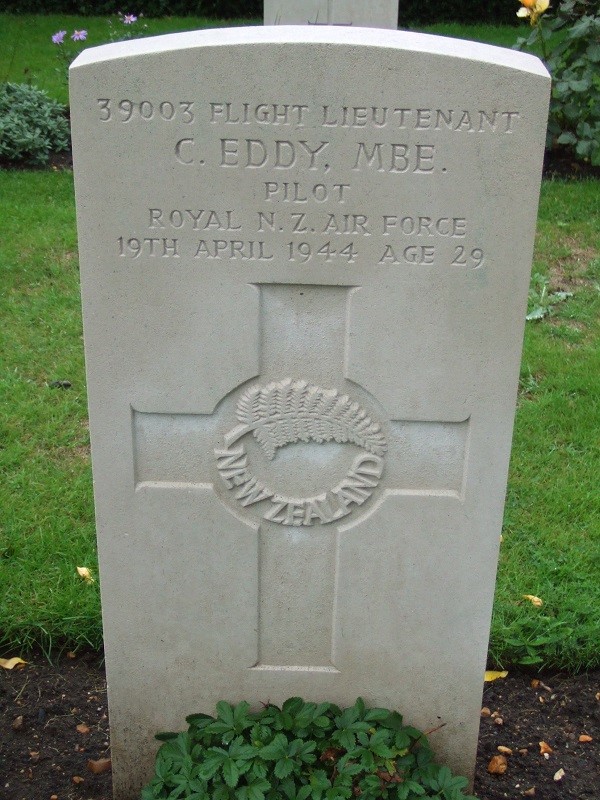Stories
Stories
Charlie Eddy, MBE
Flying Officer Charlie Eddy was awarded the MBE for gallantry in dangerous circumstances. His unselfishness in a crashed, burning bomber is indicative of the loyalty that aircrew had for one another. Sadly, Eddy was killed on another mission, five weeks before his MBE was announced.

Charles Eddy.
(Credit: Online Cenotaph)
Charles (Charlie) Eddy was born in Hamilton, Victoria, Australia but migrated to New Zealand in 1937 where he was employed as a painter by the Union Steamship Company in Wellington when war broke out. He was also serving with Wellington Fire Board in their transport and fire section
He enlisted with the RNZAF at Ohakea in September 1939, as a Driver, petrol, and served there, and later at Taieri and Wigram as Fire master, reaching the rank of Flight Sergeant until remustering to aircrew and posted to ITW Levin in September 1941.
Elementary Flying Training School at Taieri followed, then No.1 Service Flying Training School at Wigram where he was awarded his flying badge and commissioned as Pilot Office in April 1942, embarking to the UK the following month.
Following OTU and HCU, and now a Flying Officer, he was posted to 75 (NZ) Sq. on 23 January 1943, firstly at Newmarket, Suffolk, then Mepal, Cambridgeshire.
On the night of 8 March 1943, he was second pilot in the Lowe crew of 75 (NZ) Sq. on an attack against Nuremburg. On the return journey, their Stirling Mk. I (BK646 AA-N) was attacked by an enemy aircraft near Saarbrucken. The night-fighter opened fire with cannon and a stream of tracer came into the cockpit, one exploding near Eddy’s legs.
Corkscrew tactics were adopted and after seven minutes, the enemy aircraft was lost and the Stirling successfully returned to base. The only casualties were Eddy, who was wounded in the leg and P/O Lowe, who had slight face cuts.
Recovered, and now the skipper of AA-L, Eddy crash-landed at RAF Oakington, on return from operations at Aachen 14 Jul 1943. Lambert explains that a flat tyre triggered an undercarriage collapse, and the Stirling flipped on its back, before grinding to a halt and bursting into flames.
Despite his own injuries, Eddy was able drag his bomb aimer out of the aircraft. He then discovered that Eric Viccars, his mid upper gunner was still trapped in the burning aircraft. Together with a medical officer, Eddy went back into the overturned Stirling, braving the flames to rescue the trapped gunner. The fire drove them back, scorching Eddy’s face and hands. They were unable to rescue Viccars.
Eddy collapsed and was taken to hospital. Despite his injuries, Eddy returned to flying, although not for several months. He was initially posted to No.1483 Gunnery Flight, then in February 1944 to No. 1687 Conversion Unit to convert to Lancasters.
On 20th March 1944 he was posted to 115 Sq., flying from RAF Witchford in Cambridgeshire. Now Acting Flight Lieutenant, on return from his fourth operation with the new squadron – an attack on the railway yards at Rouen, France – Eddy’s Lancaster was shot down by a German night-fighter while preparing to land. All the crew members were killed.
Eddy was awarded the MBE (Member of the Most Excellent Order of the British Empire) for his bravery. The citation reads:
One night in July 1943, this officer was the pilot and captain of an aircraft which crashed when attempting an emergency landing and burst into flames immediately. He received concussion and injuries to his scalp and spine. Despite his injuries, Flying Officer Eddy remained in the aircraft and assisted the bomb aimer from the overturned second pilot’s seat. After getting clear of the aircraft, Flying Officer Eddy, on learning that one member of the crew was absent, re-entered the blazing wreckage and assisted a medical officer in a vain attempt to extricate the mid-upper gunner who was trapped in his turret. It was not until the heat, fumes and smoke had made a continuance of rescue work impossible that Flying Officer Eddy was persuaded to abandon his efforts. His face was scorched whilst he was attempting to rescue the gunner, and he collapsed immediately after finally leaving the aircraft. Flying Officer Eddy showed gallantry in dangerous circumstances and his unselfishness was instrumental in saving the bomb aimer’s life.
His MBE was announced five weeks after his death.
Eddy is buried at Cambridge City Cemetery, Cambridgeshire, England.

Charles Eddy’s Grave at Cambridge City Cemetery.
(Credit: Online Cenotaph)
Sgt. Eric Clifford Viccars, RAFVR 649196 is buried Southend on Sea (Sutton Road) Cemetery, Essex, England
References:
- Chorley W R, (1997) Royal Air Force Bomber Command Losses of the Second World War, Volume 5 Aircraft and Aircrew Losses 1944.
- Commonwealth War Graves Commission On-Line Records
- Lambert, Max, (2005) Night After Night
- Online Cenotaph
- National Archives of Australia On-Line Record B4747 Eddy/Charlie
Tail end Charlie’ over Northwest Europe – Defence Viewpoints from UK Defence Forum Monday, 25 January 2021 22:59